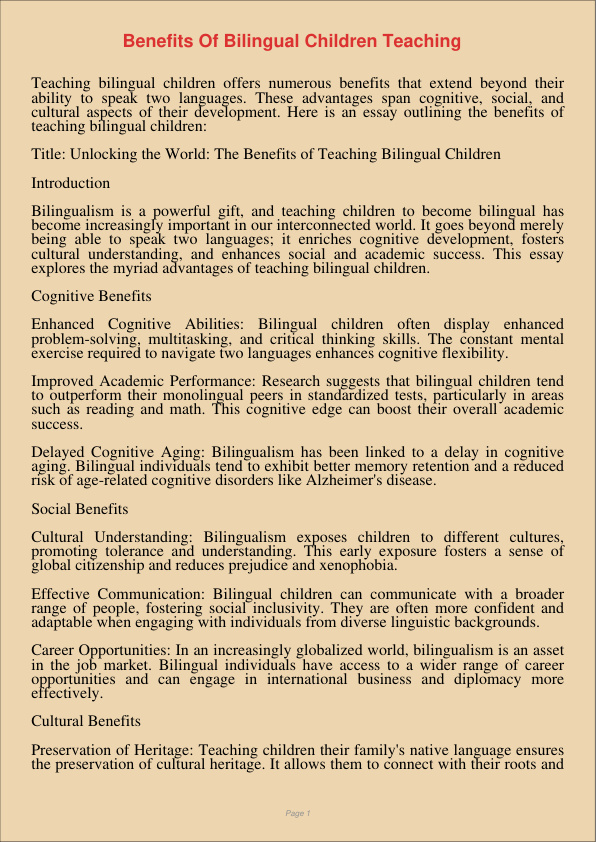Benefits Of Bilingual Children Teaching
Jan 12, 2024
bilingual children teaching
benefits
Gender & Sexual Studies
History
Teaching bilingual children offers numerous benefits that extend beyond their ability to speak two languages. These advantages span cognitive, social, and cultural aspects of their development. Here is an essay outlining the benefits of teaching bilingual children:
Title: Unlocking the World: The Benefits of Teaching Bilingual Children
Introduction
Bilingualism is a powerful gift, and teaching children to become bilingual has become increasingly important in our interconnected world. It goes beyond merely being able to speak two languages; it enriches cognitive development, fosters cultural understanding, and enhances social and academic success. This essay explores the myriad advantages of teaching bilingual children.
Cognitive Benefits
Enhanced Cognitive Abilities: Bilingual children often display enhanced problem-solving, multitasking, and critical thinking skills. The constant mental exercise required to navigate two languages enhances cognitive flexibility.
Improved Academic Performance: Research suggests that bilingual children tend to outperform their monolingual peers in standardized tests, particularly in areas such as reading and math. This cognitive edge can boost their overall academic success.
Delayed Cognitive Aging: Bilingualism has been linked to a delay in cognitive aging. Bilingual individuals tend to exhibit better memory retention and a reduced risk of age-related cognitive disorders like Alzheimer’s disease.
Social Benefits
Cultural Understanding: Bilingualism exposes children to different cultures, promoting tolerance and understanding. This early exposure fosters a sense of global citizenship and reduces prejudice and xenophobia.
Effective Communication: Bilingual children can communicate with a broader range of people, fostering social inclusivity. They are often more confident and adaptable when engaging with individuals from diverse linguistic backgrounds.
Career Opportunities: In an increasingly globalized world, bilingualism is an asset in the job market. Bilingual individuals have access to a wider range of career opportunities and can engage in international business and diplomacy more effectively.
Cultural Benefits
Preservation of Heritage: Teaching children their family’s native language ensures the preservation of cultural heritage. It allows them to connect with their roots and appreciate the customs and traditions of their heritage.
Cultural Adaptability: Bilingual children are often more adaptable when it comes to living in different countries or communities. They can seamlessly transition between different cultural contexts, bridging the gap between their heritage and the culture in which they reside.
Literary Enrichment: Bilingualism opens the door to a world of literature and art in two languages. It broadens their literary horizons and exposes them to the diverse wealth of stories, poetry, and knowledge available across languages.
Conclusion
Teaching children to become bilingual is a gift that keeps on giving. It enriches their cognitive abilities, fosters cultural understanding, and opens doors to a myriad of social and career opportunities. As our world becomes increasingly interconnected, the advantages of bilingualism become ever more apparent. Embracing bilingual education is not only an investment in a child’s future but also a celebration of the beauty of linguistic diversity. It is a gift that transcends borders and connects us to the wider world, unlocking opportunities, understanding, and empathy along the way.
